History of the uniform. Red uniforms, shakos and helmets ...
The Queen's soldiers in red coats and pith helmets fire on the Zulus in 1879. Frame from the film "Zulu" (1964)
"Captain Blow Head" Louis Boussinard
History uniforms. We continue the story about the uniform of the British army and today we will talk about uniforms of the XNUMXth century, right up to its very end and the beginning of the XNUMXth century. The British soldiers also met the wars with Napoleon in red uniforms, but outwardly their appearance was strikingly different from the appearance of the French soldiers. The fact is that with the general similarity of the military fashion of those years, the headdresses of the British, narrowed at the top, were very different from the shakos of the French, on the contrary, expanding upwards. Long trousers became a daily form of clothing, which, together with the red color of the uniform itself, made it possible to perfectly identify British soldiers even in thick gunpowder smoke.
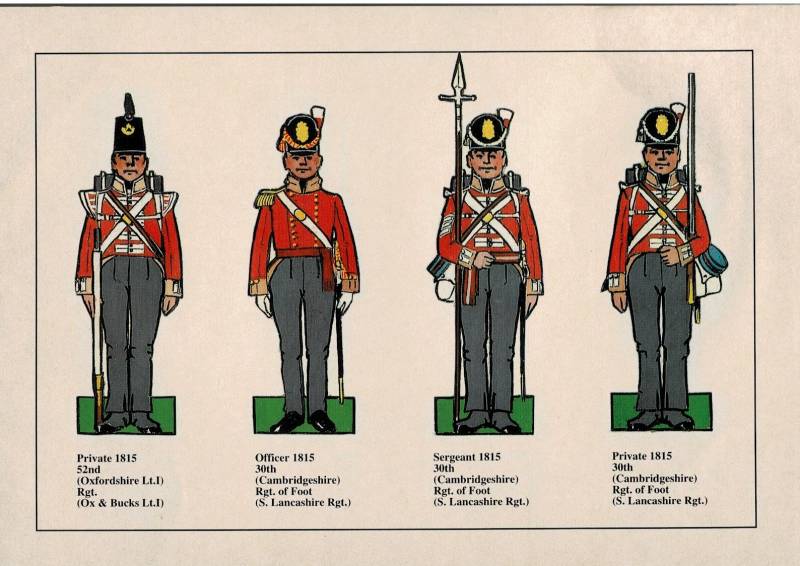
British soldiers in 1815. From left to right: 1 - private of the 52nd Oxfordshire light infantry regiment, 2 - officer of the 1815 Cambridgeshire infantry regiment, 3, 4 - sergeant and private of the same regiment. Please note: the uniform of privates and sergeants is single-breasted. Double-breasted for officers
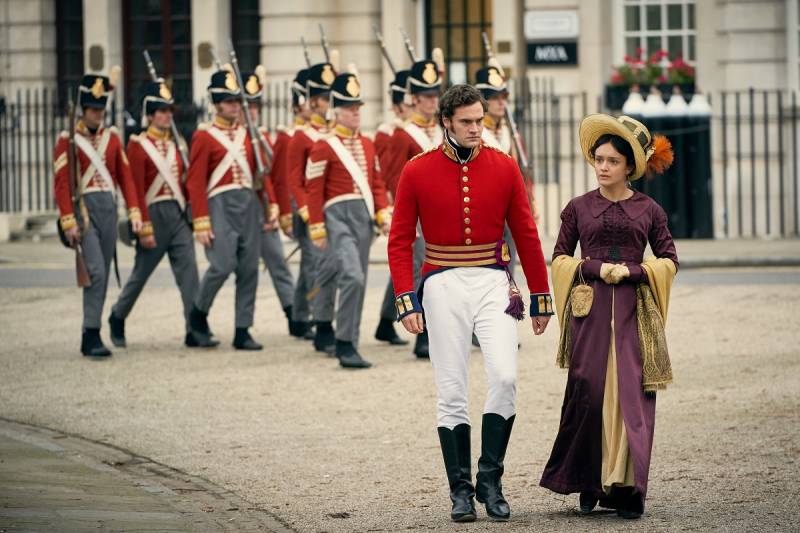
A still from the 2004 film Vanity Fair based on the XNUMX novel by William Tocqueray. This is how the soldiers of the British infantry looked like in the early XNUMXth century
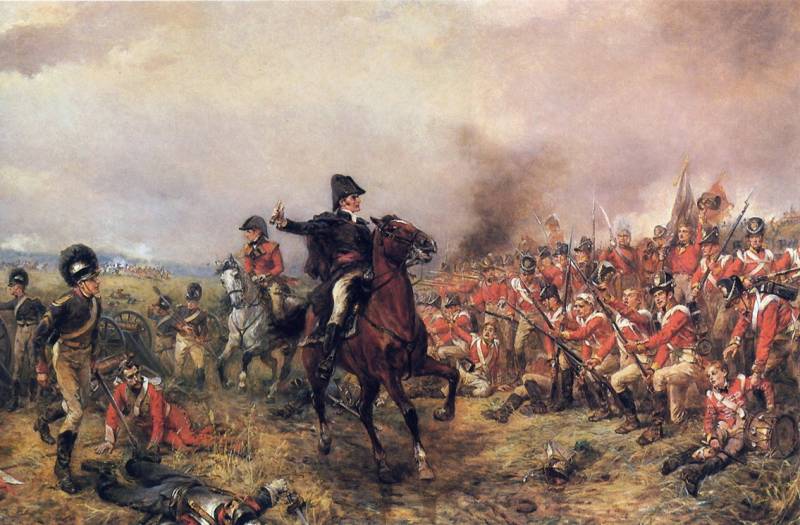
But this is how they were shown on the Waterloo field by the famous English battle painter Robert Alexander Hillingford (1828-1904). On the left, on horseback, the Duke of Wellington, and even to the left, a sergeant in the form of horse artillery.
But the huntsmen (in the English army called shooters) were dressed from head to toe in green, and their leather ammunition was not white, but black, completely invisible against a green background! In this regard, their uniform was very similar to the green uniforms of the rangers of the Russian army, who also had black ammunition.
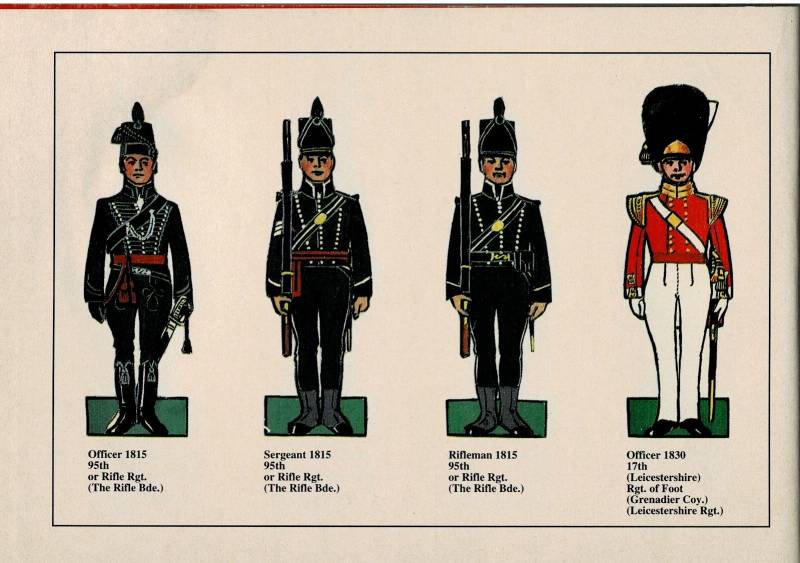
British soldiers 1815-1830 From left to right: 1, 2, 3 - officer, sergeant and shooter in 1815 of the 95th rifle regiment ("Brigade of riflemen"); 4 - officer in the new uniform of 1830, 17th Leicestershire Regiment, grenadier company
The British dragoons also wore a red uniform, but completely different from the infantry cut, and, of course, a dragoon helmet with a ponytail, so Lermontov's words about dragoons with ponytails could also be attributed to them.
Hussars ... Hussars in England wore, perhaps, the ugliest hussar uniform in Europe. That is, like everyone else, they copied it from the Hungarians, and then before their eyes they had samples of the uniform of the French, Russians, Austrians - the hussar regiments in England appeared only in 1806 - that is, absolutely everything could be copied, the means allowed. Yes, and only four regiments were created (four regiments of light dragoons were converted into them), that is, it was already possible to sew something impressive and truly hussar for them. But ... it was the English hussars who were unlucky with uniforms, and they were not lucky either with a headdress - a fur hat in the manner of a French kullback, or a mentic and a dolman - everything was there that was supposed to be a hussar, but chikchirs. For some reason, characteristic embroidery was not made on them. That is, in fact, it was ordinary and unremarkable white tight-fitting dragoon leggings! And the thing is truly amazing for a clean-shaven English army: the British hussars were still allowed to wear mustaches! By the way, with the marching uniform, both the dragoons and the hussars wore gray leggings - marching trousers, almost similar to those in which the British infantry had been walking for a long time. Another result of the frugality of the British lords was the dark blue cloth from which the hussar uniforms were sewn. Indeed, in the continental hussar regiments in each regiment, with a common cut, the colors of the uniforms were different, but here all the regimental differences were reduced to the colors of the collars and cuffs.
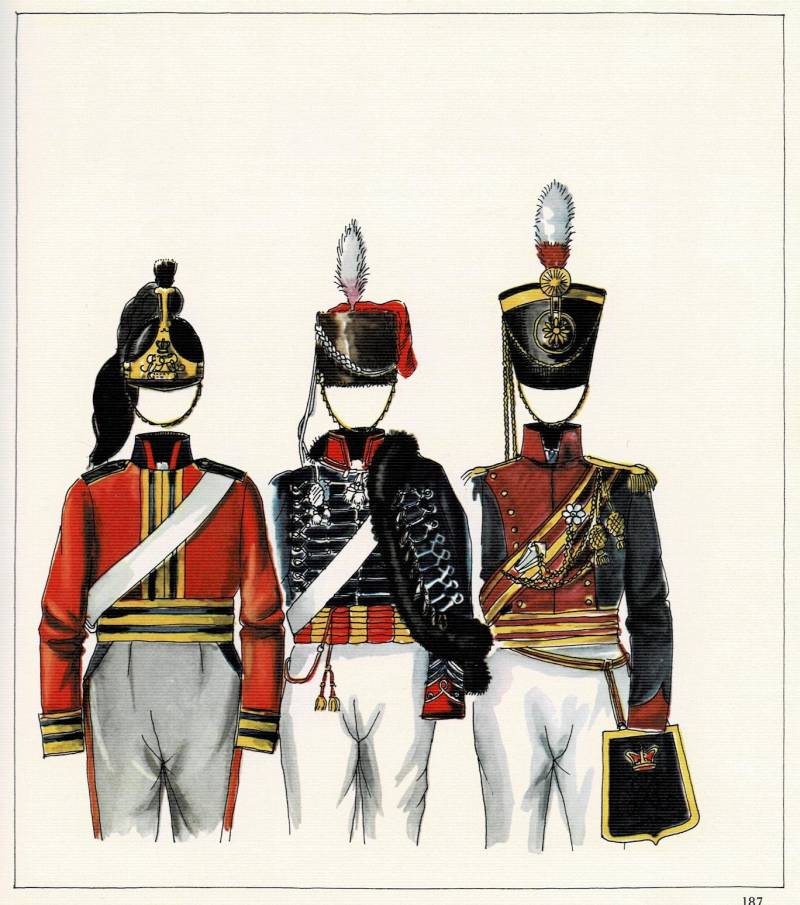
British cavalry during the Napoleonic Wars: 1 - British dragoon uniform circa 1815, 2 - British hussar uniform circa 1812. In the field they wore a shako for practical reasons, 3 - British light dragoon officer uniform circa 1812. As a headdress they introduced a shako in the shape of a bell. All cavalry regiments wore gray trousers with colored stripes in the field.
But the wars on the continent gradually subsided and the British army began a peaceful life. This means that civilian fashion began to influence her uniform to a greater extent ... So, fur hats remained only in the guards, and in army regiments they were replaced by a European-looking shako with a sultan. Officers still wore double-breasted uniforms girded with a crimson sash, while privates wore single-breasted uniforms.
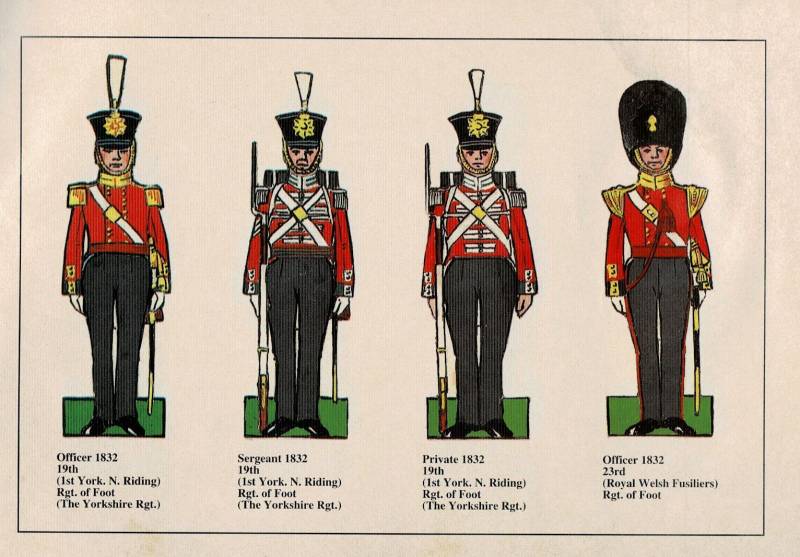
British officers and men in uniform, 1832. From left to right: 1 - an officer of the 19th Yorkshire Regiment (aka the 1st Yorkshire N. Reading Infantry Regiment), 2 - a sergeant of the same regiment, 3 - a private of the same regiment, 4 - an officer of the 23rd Infantry Regiment of the Welsh Royal Fusiliers
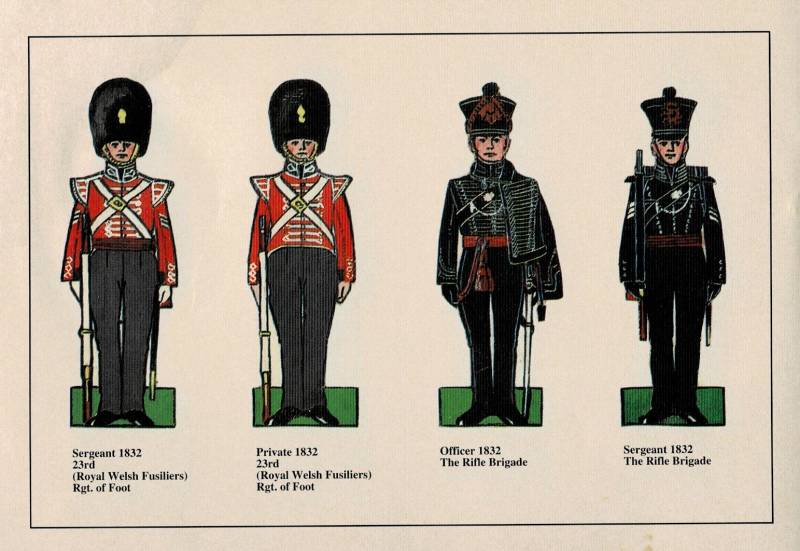
British officers and men in uniform, 1832. From left to right: 1 - sergeant, 23rd Infantry Regiment of the Welsh Royal Fusiliers, 2 - private of the same regiment, and both of the grenadier company, judging by their caps, 3 - officer of the Fusiliers Brigade, 4 - private of the same brigade
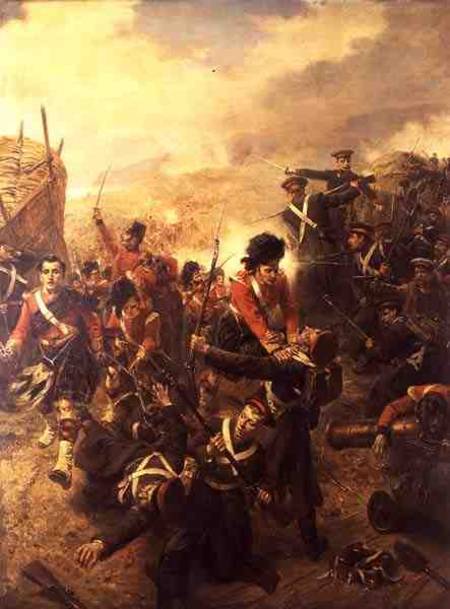
An impressive painting by the artist R.A. Hillingford "Attack of the Redan in Sevastopol" 1899 Private collection
It was during the years of the Crimean War during the battle of Balaklava that the two-rank formation, which became very popular in the British infantry, was born, replacing the four-rank formation. Rapidly firing and reloading their rifles, the Sutherland Highlanders managed then to repulse the Cossack attack without loss. However, the English historian J. Denison pointed out that the Russian Cossacks had no intention of attacking, but were simply engaged in reconnaissance of the enemy forces.
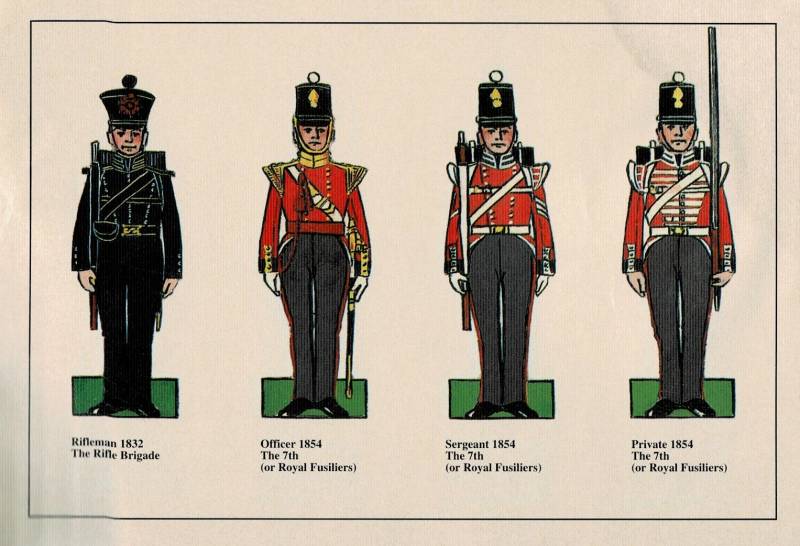
British officers and soldiers in uniforms 1832-1854: 1 - rifleman of the rifle brigade, 2 - officer 1854 of the 7th regiment of the Royal Fusiliers, 3 - sergeant of the same regiment, 4 - private of the same regiment
Interestingly, even the crowned heads had a hand in the design of the uniform of the British army, in particular Prince Albert, who proposed the so-called "Albert shako" (also known as Albert sweat), which was worn in the British army from 1844 to 1855. He proposed it in 1843 as a replacement for the flared shako then in use.
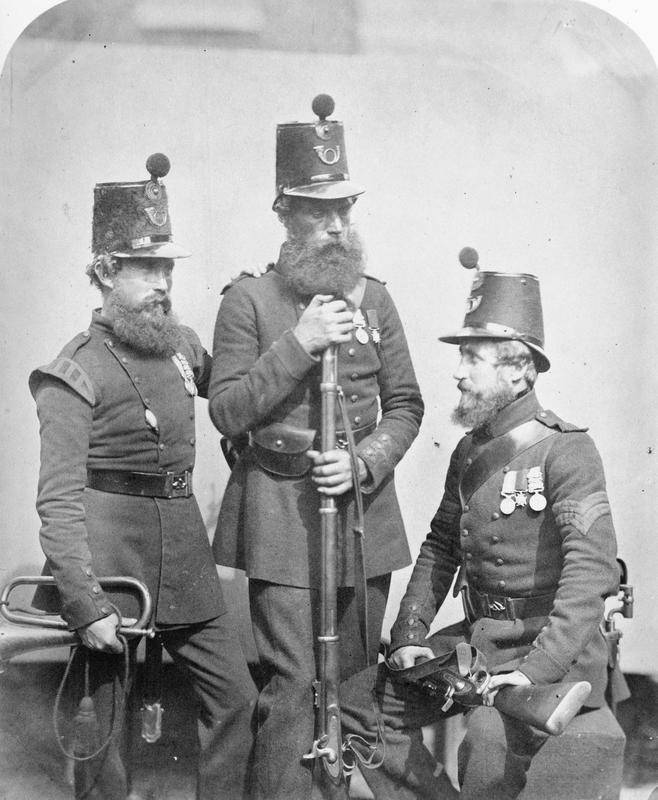
Soldiers of the Rifle Brigade in Albert's shakos during the Crimean War
Since 1856, the uniforms have changed again, and besides, now not only the hussars, but also the infantry were allowed to wear sideburns and mustaches. Uniforms for everyone became double-breasted, and ammunition was replenished with a container for capsules. Interestingly, before 1856, officers often bought their own firearms. weapon. For example, it could be, say, Colt revolvers. However, the Adams revolvers were considered superior due to their double action and heavier bullets with good stopping power. In the same year, the Beaumont-Adams revolver entered service. It was replaced by the unpopular Enfield revolver in 1880, which was in turn replaced by the Webley revolver in 1887.
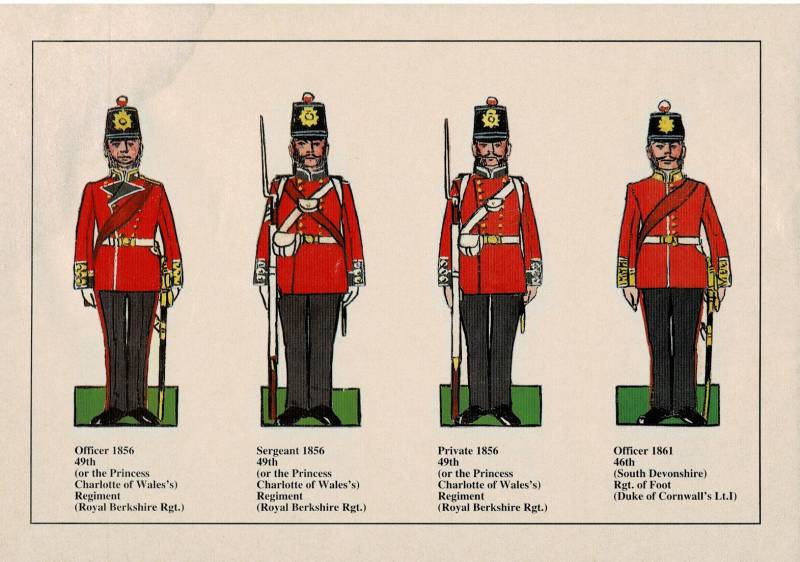
British officers and soldiers in uniforms 1856-1861: 1 - officer of the 49th Royal Berkshire Regiment (or Princess Charlotte of Wales), 2 - sergeant of the same regiment, 3 - private of the same so far, 4 - officer of 1861 of the 46th of the South Devonshire Regiment of Foot (aka The Duke of Cornwall's Light Infantry)
In 1861, the uniforms for both privates and officers became single-breasted. More of their cut has not changed. The headgear was a leather helmet in the manner adopted at the same time in Europe. They stopped girdling themselves with a crimson-colored scarf and wore it over their shoulder: officers over the left, sergeants over the right.
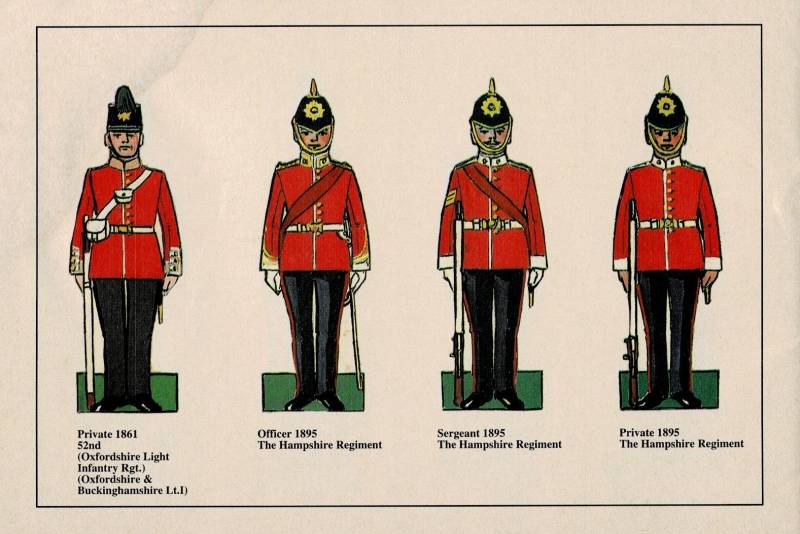
British officers and soldiers in uniform 1861-1895: 1 - Private of the 52nd Oxfordshire Light Infantry Regiment (Oxfordshire and Buckinghamshire Light Infantry), 2 - Officer of the Hampshire Regiment, 3 - Sergeant of the same regiment, 3 - Private of the same regiment
The Highlanders were dressed in trousers, but retained their traditional clan colors.
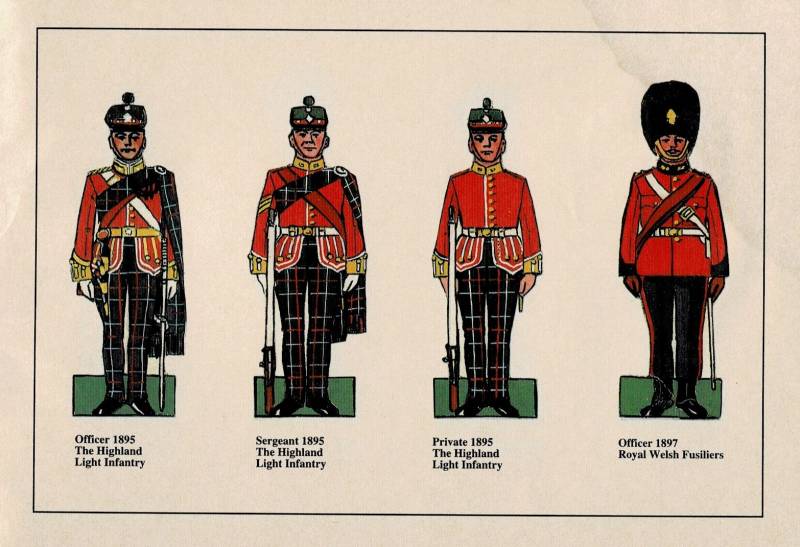
British officers and men in uniform 1895-1897: 1 - officer of the Highland Light Infantry, 2 - sergeant, 3 - private, 4 - officer of the Welsh Royal Fusiliers 1897
In 1898, during the Kitchener campaign in the Sudan, the best units of the Connaught Rangers and the North Staffordshire Regiment wore their red coats at the Battle of Omdurman, and were the last British troops to wear them in battle, although it is possible that some units of the red coats still wore it.
But the fact that they fought in red uniforms at the Battle of Isandlwana and at Rorke's Drift is beyond doubt. And quite correctly shown in the movies "Zulu" (1964) and "Dawn of the Zulu" (1979).
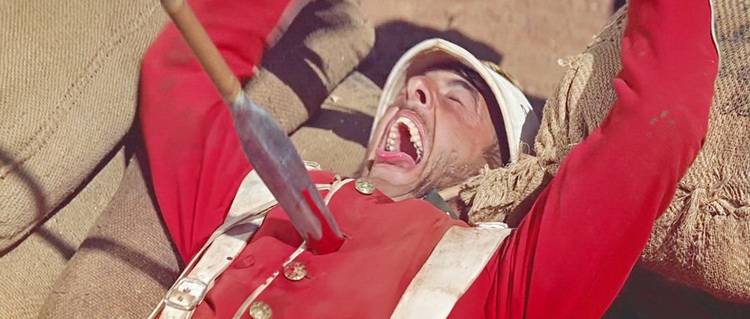
And this is how British soldiers in red uniforms died under the Zulu assagai! A very realistic shot from the movie The Zulus (1964)
To be continued ...
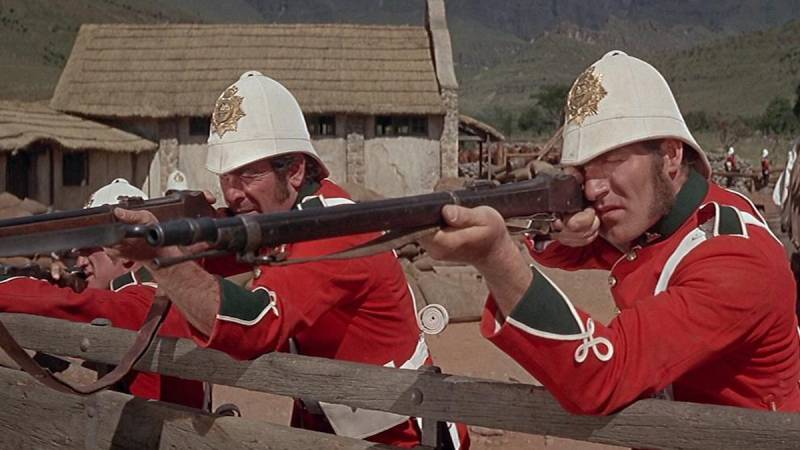
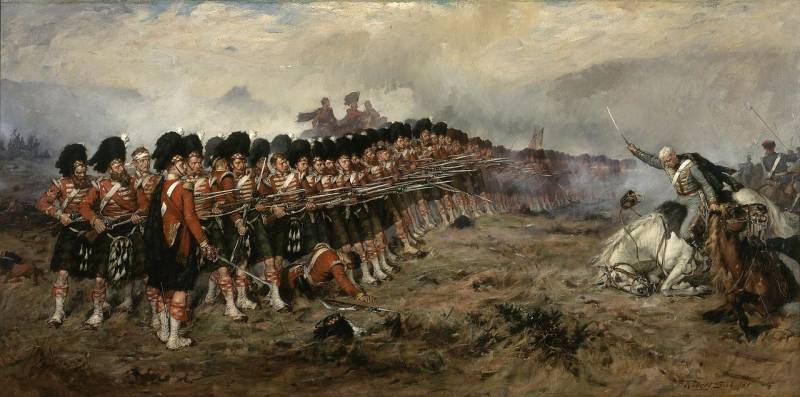
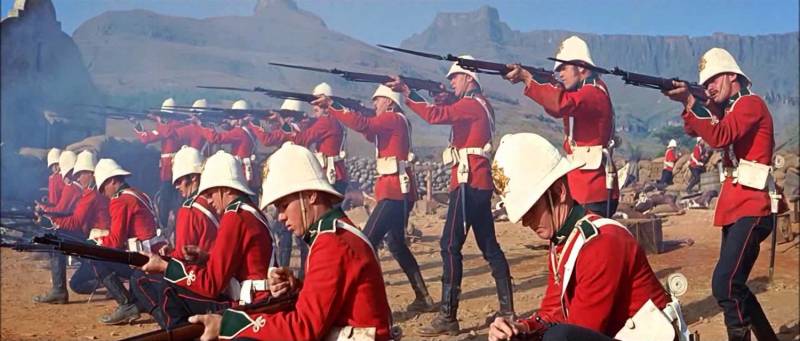
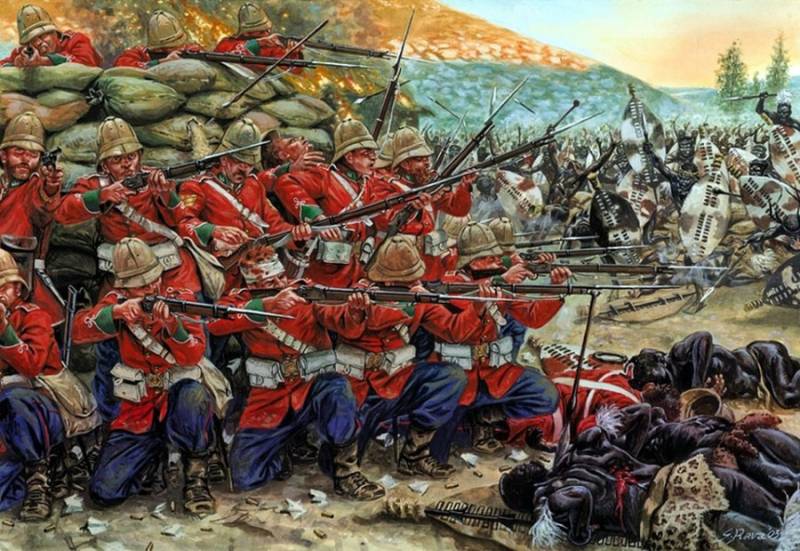
Information